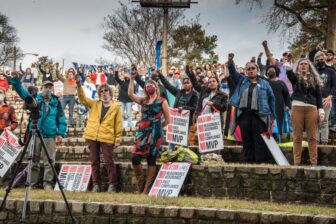A Common Person’s Guide to the American Clean Energy and Security Act of 2009
On May 21st, following months of work, the House Energy and Commerce Committee passed the American Clean Energy and Security Act of 2009 (ACESA), a 932-page piece of climate legislation. There have been mixed reactions from environmental and climate groups, but most groups are in agreement that it needs to be strengthened going forward. For some groups the problems they see with the bill have led to their public withdrawal of support. These groups include Greenpeace USA, Public Citizen and Friends of the Earth. The Chesapeake Climate Action Network also does not support the bill in current form.
Below is a summary analysis of the main features of the bill.
–Cap and Trade System: The bill would establish a “cap-and-trade” system that sets mandatory and declining limits on greenhouse gas emissions over the next 40 years. By 2050 it projects reductions of 83% from 2005 levels for the United States. It does this primarily through the establishment of 1) a “cap” on emissions and the annual issuance by the government of permits to emit greenhouse gases, both of which–the cap and the emissions permits–come down steadily year after year, and 2) a tradable market to buy and sell those permits to emit global warming pollution. That’s why it’s called a “cap-and-trade” system.
–Wide-Open Buying and Selling: Significantly, this market is open to anyone, not just those entities which emit greenhouse gases. For example, Wall Street firms whose primary purpose is to make money for their investors can buy and sell pollution permits. Anyone, whether Goldman Sachs or John Q. Public, can get into this newly-created market. From page 430 of the bill: “The privilege of purchasing, holding, selling, exchanging, transferring, and requesting retirement of emission allowances, compensatory allowances, or offset credits shall not be restricted to the owners and operators of covered entities, except as otherwise provided in this title.” Especially following the sub-prime mortgage/credit/banking crisis, there is concern among many people, including some on Capitol Hill, about the potential for this system to be abused by those out to make quick and big profits.
–Goals and Targets: The document states that one of its prime objectives is to help the world “avoid atmosphere greenhouse gas concentrations above 450 parts per million carbon dioxide equivalent; and global surface temperature 3.6 degrees Fahrenheit (2 degrees Celsius) above the pre-industrial average.” However, a growing number of scientists, journalists and climate activists believe that we need to reduce emissions more deeply if we are to have a good chance of avoiding climate catastrophe.
–2020 Targets: It projects a 17% reduction in greenhouse gases (ghg) from 2005 levels by 2020. This is about 3% below U.S. ghg levels in 1990; 1990 is the baseline year used by the nations of the world. There is an additional 10% reduction of ghgs projected via investments in the prevention of deforestation outside the United States, and there could be a few percent more reductions through other means. This could add up to about a 20% reduction by 2020 compared to 1990 levels. The world’s international climate negotiators have called for industrialized countries to reduce their emissions by 25-40% below 1990 levels by 2020.
–Upstream, Downstream: It appears that the cap is a mix of “upstream” and “downstream.” “Upstream” means the earliest point at which carbon fuels (coal, oil, natural gas) or other global warming pollutants enter the economy; “downstream” means at a point further along. An “upstream” cap reduces the number of covered entities and makes it easier to reduce or eliminate leakages from the system. A summary of the document says that it “establishes a market-based program for reducing global warming pollution from electric utilities, oil companies, large industrial sources and other covered entities that collectively are responsible for 85% of U.S. global warming emissions.” It describes a “covered entity” as one which emits at least 25,000 tons of ghg emissions annually.
–Offsets: There is a very large provision made for “offsets.” An “offset” is when a company contributes money for a renewable energy, energy efficiency or other “clean energy” project somewhere else instead of reducing its own greenhouse gas emissions. This piece of legislation allows for up to 2 billion tons worth each year, which is more than 27% of the U.S.’s total annual ghg emissions. The offsets would happen in both the U.S. and in other countries; up to 3/4 of them could be in other countries. There is much controversy over offsets; a recent study, for example, reported that between 1/3 and 2/3 of them under the Clean Development Mechanism of the Kyoto Protocol, an international treaty, were for projects that likely would have happened anyway. If fossil fuel companies used all of the offsets, there would likely be no, or very little, actual reductions of carbon emissions by these companies until the middle of the 20’s. This would be the case even if ghg emissions permits were auctioned.
–Free Pollution Permits: A huge percentage of the permits to emit ghgs will be given away rather than sold via an auction. Only 15% of the permits will be auctioned for roughly the first 15 years or so of the program, despite President Obama’s strong support for a 100% auction during his campaign and for the first couple of months of his presidency. Coal companies are the big winners; “local distribution companies,” which are overwhelmingly coal-related, and “merchant coal” companies receive 35% of the permits, also known as “allowances” (as in an allowance to emit global warming pollution). The 30% to “local distribution companies” represents 90% of total electric utility emissions. This system will remain in place until 2030, with a five-year phase out between 2026 and 2030. Other global warming polluters who receive free allowances are local natural gas distribution companies (9% of the permits), “energy-intensive, trade-exposed industries” like steel, paper, aluminum and cement (15%), oil refiners (2%), and coal companies to “cover the costs of installing and operating carbon capture and sequestration technologies” (2% from 2014-2017 and 5% after that). This adds up to about 65% of the allowances being given for free to carbon polluters, 50% to the fossil fuel industry directly.
–Consumer Protection?: Interestingly, most of these free allowances to carbon polluters are described as “consumer protection” even though no consumer organizations were advocating for this plan. The advocates for it were representatives like Congressman Rick Boucher of Virginia who received over $176,000 from the coal industry for the 2007-2008 Congressional election cycle. Since the passage of this bill out of committee Boucher has said publicly that that the legislation will “create the opportunity for increasing coal production.” The legislation assumes that coal companies and other large corporations can be trusted, or regulated, to pass along to consumers the savings they will gain from the free permits they will be given. And remember that they can sell these emissions permits, or allowances, on the cap-and-trade, carbon/ghg market that is being set up.
–More on Consumer Protection: A statement by Public Citizen on this bill contained this sentence: “The committee’s plan to distribute allowances to coal utilities will set up a legal fight in all 50 state utility regulatory commissions over how exactly the money will be returned to families and how much utilities can skim off the top




